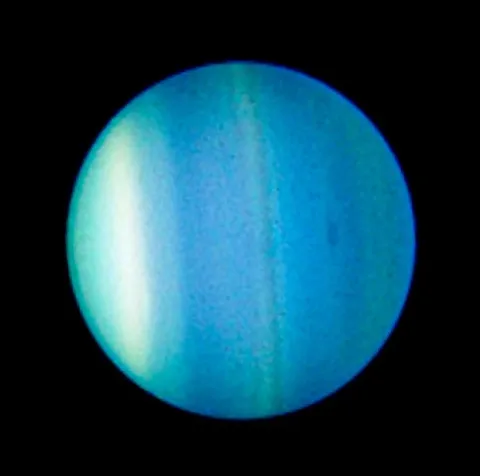
Uranus is the seventh planet from the Sun and is one of the four gas giants in our Solar System. It is a unique world, known for its striking blue-green color, which results from the methane in its atmosphere, and its extreme axial tilt, which causes it to rotate on its side. Discovered relatively late in human history, Uranus has intrigued astronomers with its unusual characteristics and has become a key object of study in understanding the outer reaches of our planetary neighborhood.
History and Mythology
Uranus was discovered by British astronomer William Herschel on March 13, 1781. Initially mistaken for a star or a comet, it was later confirmed to be a new planet, the first to be discovered with a telescope. The planet was named after the ancient Greek god of the sky, Uranus, who was the father of the Titans and the grandfather of Zeus in Greek mythology. This naming continued the tradition of associating planets with deities from ancient mythologies.
In mythology, Uranus (or Ouranos) was the primordial god of the sky, representing the heavens that enveloped the Earth. His story is one of power and downfall, as he was overthrown by his son, Cronus, symbolizing the cyclical nature of time and generational change.
Moons
Uranus has 27 known moons, most of which are named after characters from the works of William Shakespeare and Alexander Pope. The five major moons are Miranda, Ariel, Umbriel, Titania, and Oberon.
- Miranda: The smallest of the five major moons, Miranda is known for its extreme geological features, including large canyons, ice cliffs, and ridges. It appears to have undergone significant tectonic and volcanic activity, leading to a surface that is a patchwork of varied terrains.
- Ariel: Ariel is the brightest and possibly the youngest of Uranus's moons, with a surface marked by extensive fault valleys and smooth plains, suggesting recent resurfacing by icy volcanism or tectonics.
- Umbriel: Umbriel is the darkest of the five major moons and is heavily cratered, indicating an ancient surface. Its most prominent feature is Wunda, a large crater with a bright ring, possibly indicating the presence of ice or frost.
- Titania: Titania is the largest moon of Uranus and is notable for its large canyons and fault lines. Its surface shows signs of geological activity, including fault valleys that extend for hundreds of kilometers.
- Oberon: Oberon, the second-largest moon, is heavily cratered, with its surface showing signs of ancient impacts. It has a few large, dark patches that might be the result of some kind of resurfacing or outgassing.
Statistics
- Diameter: 50,724 km (31,518 miles)
- Mass: 8.68 × 10^25 kg (14.5 Earths)
- Distance from Sun: 2.87 billion km (1.78 billion miles)
- Orbital Period: 84 Earth years
- Rotation Period: 17 hours 14 minutes
- Axial Tilt: 97.77 degrees
- Atmosphere: Primarily hydrogen and helium, with a significant amount of methane
- Temperature: Average of -224°C (-371°F), making it the coldest planet in the Solar System
Probes That Have Visited
Only one spacecraft has visited Uranus to date:
- Voyager 2: Launched by NASA on August 20, 1977, Voyager 2 made its closest approach to Uranus on January 24, 1986. It provided the first and only close-up images of the planet, its rings, and its moons. The spacecraft discovered 10 new moons, studied the planet's atmosphere, and gathered data on its unique magnetic field, which is both offset from its center and tilted at a steep angle compared to the planet's axis.
Fun Facts
- Sideways Planet: Uranus's extreme axial tilt of about 98 degrees means it essentially rotates on its side, leading to extreme seasonal variations. Each pole gets around 42 years of continuous sunlight, followed by 42 years of darkness.
- Faint Rings: Uranus has a system of 13 faint rings, which were discovered in 1977. These rings are composed mostly of dark, microscopic particles and are much less prominent than those of Saturn.
- Magnetic Field: The planet's magnetic field is unusual in that it is both off-center and tilted at 59 degrees from the axis of rotation, creating complex and asymmetric magnetic poles.
- Methane Atmosphere: The blue-green color of Uranus is due to methane in the atmosphere, which absorbs red light and reflects blue light.
Plans to Visit
As of now, there are no immediate plans for a dedicated mission to Uranus, but it is a high priority for future exploration. The planet's unique characteristics, such as its extreme tilt and complex magnetic field, make it a compelling target for a dedicated orbiter or flyby mission. Proposed missions could include a comprehensive study of the planet’s atmosphere, magnetic environment, rings, and moons, much like the Cassini mission did for Saturn. NASA and other space agencies have shown interest in exploring Uranus further, and discussions continue about the best approach to uncover more about this enigmatic ice giant.
Uranus remains one of the least understood planets in our Solar System, with its mysterious tilt, cold temperatures, and numerous moons providing a wealth of scientific opportunities. Future missions to Uranus could unlock many secrets about the formation and evolution of the outer planets.
